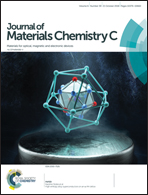Rational design strategies for electron-deficient semiconducting polymers in ambipolar/n-channel organic transistors and all-polymer solar cells
Abstract
The past two decades have witnessed significant progress in the field of organic electronics, especially polymer thin-film transistors (PTFTs) and polymer solar cells (PSCs), which provide a promising opportunity for applications in flexible and wearable devices. Thanks to the efforts of the rapid development of p-type semiconducting polymeric materials and device optimization, an impressive hole mobility over 10 cm2 V−1 s−1 and power conversion efficiency near 15% have been achieved in PTFTs and PSCs, respectively. However, the development of electron deficient semiconducting polymers for ambipolar/n-type PTFTs and polymer donor–polymer acceptor type PSCs (all-PSCs) lags far behind. Therefore, the design and synthesis of new electron-deficient semiconducting polymers have attracted increasing attention during the past five years. This review attempts to critically summarize the recent molecular design strategies with respect to the electron-deficient semiconducting polymers. These polymers have demonstrated interesting electronic properties and promising performances as active layers in ambipolar/n-type PTFTs and all-PSCs. The molecular structural implications related to the ambipolar/n-type device performances of the PTFTs and all-PSCs are discussed.



 Please wait while we load your content...
Please wait while we load your content...